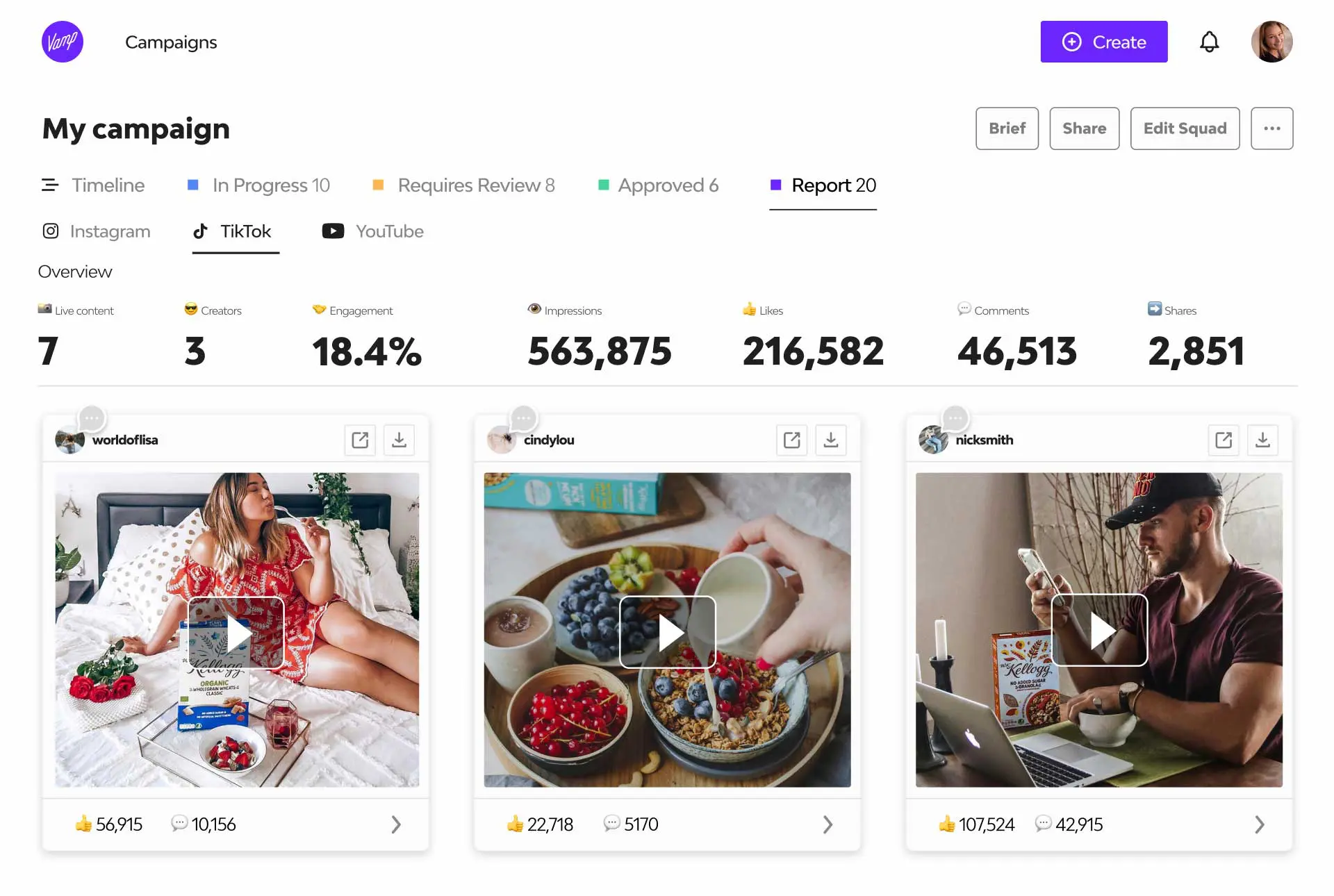Was your influencer campaign successful? Was it a good use of your marketing budget? Only your results can tell you that.
By interpreting your data and measuring your results thoroughly, you’ll learn which of your campaign objectives were achieved and how far you smashed them out of the park. It’s the only way to decide whether influencer marketing is a worthwhile investment for your brand.
Where can you access this data?
When running an organic influencer campaign yourself, you’ll need to ask your creators for their performance data and combine them to get your overview results. If you’re using Vamp’s platform, our creator’s performance data is linked directly to the dash. You can see impressions, reach engagements and more, all updates in realtime in the report tab, so you can monitor your campaign’s performance during and after the campaign. As official partners of Instagram and TikTok, we can provide the most accurate, in depth data.
You may want to track multiple metrics. But usually, based on your objective, there will be one or two that will be particularly important indicators that tell you how your campaign performed. For example, if your campaign was all about driving conversions, you won’t be focussed on the Story completion rate. Instead, you’ll want to pay close attention to your ROAS.
If you’ve never interpreted campaign results before, this guide will teach you how to decode your data to ensure you get the most out of your influencer marketing campaigns.

How to interpret your organic results
Impressions and reach
If your goal is to boost awareness for your brand or product, then your reach and impressions are the metrics to watch. They indicate how many people have seen your campaign content (reach) and how many times your content was displayed (impressions).
For awareness-driving campaigns, the higher these numbers are, the better. Just keep in mind that impressions are usually higher than reach, as someone could see a post or re-watch a Story multiple times.
Completion Rate
With 500 million monthly users, Stories is one of Instagram’s most popular and engaging features. But with no likes, comments or saves, how do you know if your Story content achieved your engagement objectives?
Enter ‘Completion Rate’. This metric is the percentage of viewers that watched the entire story sequence – from start to finish. A high completion rate is a good indicator of how engaged your audience is with the Story. A good average completion rate should sit at around 75%, according to Rival IQ.

Engagement rates
People may have seen your post, but how many tapped the like button, commented or saved for later? The average engagement rate will explain the extent of reaction driven by your campaign. A high engagement rate means your campaign resonated with your audience and encouraged them to interact with the content – not just look at it.
There are two different ways to calculate your engagement rate:
#1 Traditional: This takes into account the number of likes and comments a post gets, balanced against the number of followers an account has. A high number of followers, but a low number of likes and comments indicates a low level of engagement. Lots of likes and comments in relation to the following indicates strong engagement and is what we’re looking for in an influencer campaign.
The formula: (The number of likes + comments + saves ÷ no. of followers) x 100.
#2 Unique: An accurate engagement rate determined by Instagram’s API. Opposed to the traditional engagement rate, this is measuring the percentage of actions taken on the content based on the number of impressions. This engagement rate can be compared to platform and industry benchmarks. For example, the median engagement rate across all industries on Instagram is 0.98%, according to Rival IQ. Our campaign with Moose Toys achieved a 1.8% engagement rate, outperforming the industry benchmark by a whopping 168.7%.
The formula: (The number of likes + comments + saves) ÷ impressions x 100.
Pro tip: Micro influencers tend to receive a higher engagement rate, compared to macro influencers. Although macro influencers can deliver high reach and impressions, micro influencers usually have a more engaged following. Not only do they feel more relatable, but they often have more time to interact with their audience, forming deeper connections.
Saves
Sometimes overlooked, saves actually give you more information about your audience than you realise. They suggest people want to come back to that post later. Possibly to research or purchase the product your creator was promoting.
How to interpret your paid media results
Conversion rate
A high conversion rate means your ad content was persuasive enough to turn a social scroller into a blog reader, website visitor, app downloader or shopper. There are many factors, including the industry vertical and the content type, that will determine if your conversion rate is ‘good’. As a starting point, the average Instagram ad conversion rate is 1.08%, according to Shopify.
To calculate this result, you need to look at the percentage of users who took a desired action against the number of users who saw the ad. For example, let’s look at the percentage of social users who follow a call to action that takes them to your ecommerce site. If your ad is seen by 100,000 users and 2,000 users click the call to action, the post’s conversion rate is 2%.
The formula: Reach ÷ link clicks.
CPE and CPC
To find out if your paid media campaign was achieving cost-effective results, you want to take a look at your CPE and CPC. Also known as cost per engagement and cost per click, these refer to how much it costs to achieve one engagement and one link click. Unlike the other results we’ve spoken about so far, you actually want these to be low.
On average, brands pay between $0.20 and $2 per click on Instagram ads, according to Web FX. Whereas the platform’s average CPE is $0.085, according to Revealbot.
The formula: Paid media budget ÷ engagements. Or paid media budget ÷ link clicks.

ROAS
Also known as return on ad spend, or as we like to call it, the money making result. Here, you’re looking for the highest possible number. A high ROAS means your campaign was successful in driving lots of sales for your brand, compared to how much you spent to achieve those results.
For example, our campaign with Selfridges had a 113x return on ad spend, which means the campaign generated $113 for every $1 spent. To work out this result, you take the total revenue generated for a specific marketing channel and divide it by the total spend on that channel.
A ‘good’ ROAS varies depending on your marketing channel and industry vertical. To give an example, the ROAS benchmark for house and home brands who advertise on Instagram is 17.42x, whereas the benchmark for food and drink brands is 2.69x, according to Sidecar’s 2021 Benchmark Report.
The formula: Revenue ÷ spend.
How to learn from your data
Decoding your data to find out what worked – and what didn’t – will allow you to plan effectively for the next campaign you run. You’ll begin to learn what type of content drives successful results among your target audience and what doesn’t. You can use these learnings to ensure your future campaigns are successful.
As well as looking at the overview of results, you should also delve into individual creator performance. This will help you decide who you should engage with again, and which creators aren’t the best fit for your brand. Ongoing influencer partnerships have proven to deliver excellent results for Vamp’s clients.
Social media marketing glossary: including ROAS, CPE and impressions

